How to Improve Your Swimming Speed
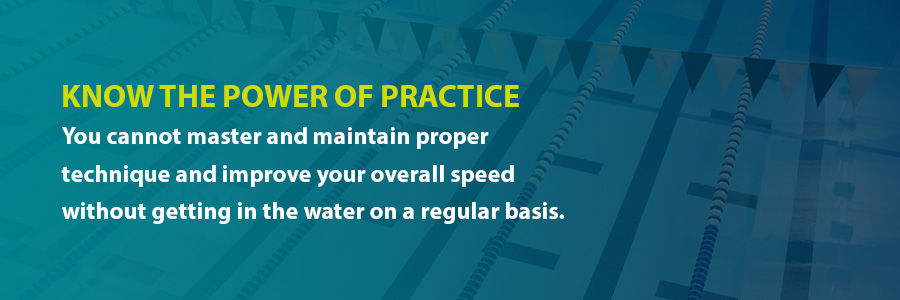
Swim Tips, Swimming News
|
October 24, 2022
How to Improve Your Swimming Speed
In 2010, Michael Phelps reached a swimming speed of about six miles per hour. The record for swimming a men's 50-meter short course (50 meters in a 25-meter pool) is 20.91 seconds. Not every swimmer is going to achieve Olympic Gold and record-shattering speeds, but it does spark inspiration to move faster through the water during your swim workouts. The four basic swimming strokes are freestyle, breaststroke, backstroke and butterfly. While you move your body differently for each stroke, the main determinants of speed are thrust and drag. The water provides resistance (or drag) while your arms and legs propel (or thrust) you through the water. Learning how to effectively move your body through the water for each different stroke will help improve your time.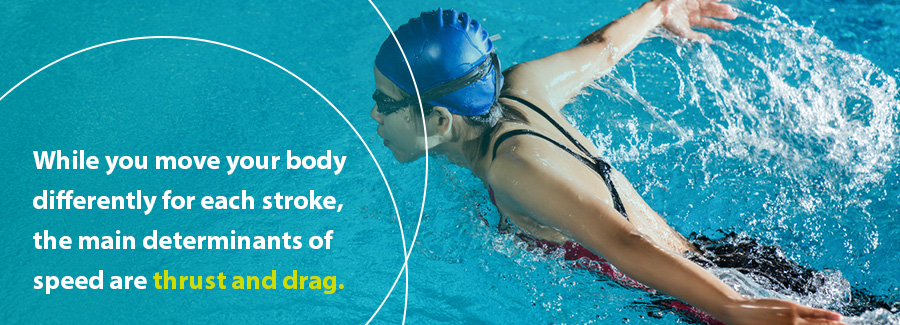 Once you have the basic arm and leg movements down for the stroke you're trying to speed up, you can focus on the nitty-gritty elements of your swim time. You can shave valuable fractions of a second off of your time by improving each of these elements:
Once you have the basic arm and leg movements down for the stroke you're trying to speed up, you can focus on the nitty-gritty elements of your swim time. You can shave valuable fractions of a second off of your time by improving each of these elements:
- Underwater time: This number is the total time you spend under the water.
- Turn time: Turn time is the amount of time it takes you to turn and begin your next lap.
- Cycles: In swimming, one cycle is the equivalence of a single stroke. So, your cycle count is the number of strokes it takes to finish your timed swim.
- Stroke rate: This rate is the average speed of your strokes. To determine stroke rate, you should divide the number of strokes taken during your timed swim by the total time.
- Reaction time: If you're taking off from the blocks, this term refers to how long it takes you to get from the block to the water.
Focus on Your Arm Movement
Your arms do a lot of the work it takes to move you quickly and efficiently through the water. You can calculate your own stroke count by noting each time your arm enters the water during freestyle, backstroke, breaststroke or butterfly. Remember, when swimming backstroke and freestyle, your arm movements are not synchronized. That means you have the choice of counting in half cycles of full cycles. For a half cycle, you'll count when either arm enters the water. For a full cycle, you will only count when your left or right arm enters the water. To become faster, swimmers can either reduce the number of strokes it takes to cover a certain distance or make their strokes faster. During your next workout, count your strokes. The number you get can be a great baseline to see how different arm techniques change your stroke count and overall time. Shop Swim EquipmentFreestyle
When you swim freestyle, your arms account for 90 percent of your thrust through the water while your legs do what little work is left. That means knowing the proper arm technique and refining it will help you improve your speed. In freestyle, your arms move in an alternating fashion. One arm is beneath the water, stretched forward as far as possible, while the other is out of the water, arching above your body. The arm that is above the water is bent, with your hand and fingers completely straight. Your hand will enter the water first, while your elbow comes last. Pull forward and allow your arm to go all the way back to your waist before you begin your next stroke. As you alternate arms, your body will slightly rotate in the direction of the arm above you.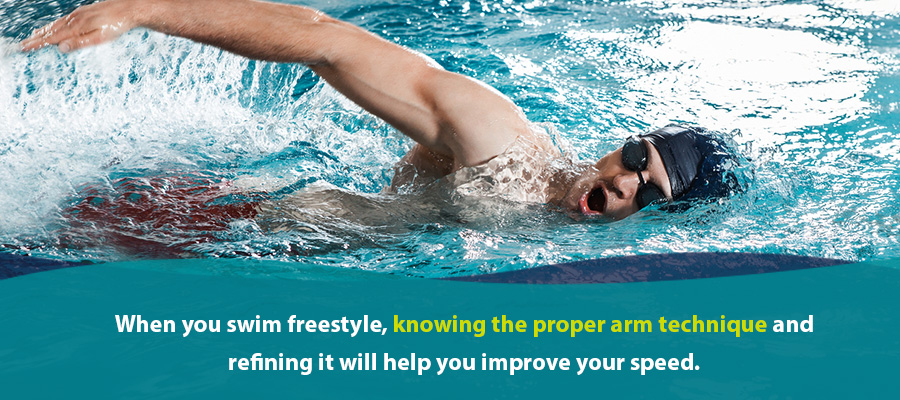
Backstroke
When swimming backstroke, you also use an alternating arm movement, but your arms will remain straight when out of the water. As one arm comes up, keep it fully extended, and rotate your palm to face outward as you move your upper arm — then the rest of the arm — into the water. The arm then completes a down sweep. You will then pull your bent arm backward to help push you through the water. The upsweep movement occurs when the arm and palm rotate to face inward. You will then move your arm up out of the water.Breaststroke
When you're swimming breaststroke, proper arm movement begins with both arms stretched out in front you, palms facing outwards. You will move both of your arms outward. Then, bend your arms so that your palms are lined up with your forearms. Next, your arms will begin to move backward, and then bring your arms up toward your chest with your palms facing one another. Once you have completed this movement, you will extend your arms in front of you, and the stroke begins again.Butterfly
The arm movement for butterfly is similar to that used in freestyle, except your arms both move at the same time instead of alternating. It can be easy to mimic the arm movements by watching other swimmers, but the finer details might get lost. Focus on honing your movements. This focus on precision can help you to become a faster swimmer.Refine Your Kick
How you move your legs in the water is just as important as how you move your arms. Here is how to improve speed in swimming by enhancing your kick technique.- Freestyle and backstroke: Both freestyle and backstroke use the flutter kick to move you through the water. It might seem counterintuitive, but bigger kicks do not necessarily mean better. The flutter kick involves quickly moving your legs up and down in an alternating fashion. When you kick, try to keep your knees as straight as possible. If you bend them too much, your legs will do very little to move you through the water. While you kick, concentrate on making smaller movements. You don't need to make big splashes with your feet.
- Breaststroke: The synchronous leg movement used for breaststroke is often called the "frog kick" because your legs move much like the amphibians'. First, your legs bend at the knee and the hip, coming up beneath your torso. Next, you turn your toes and knees out as you move your legs apart. Your legs will move downward and outward in a circular motion. As they come close to completing the circle, move your toes and heels back into a straight line. Repeat the circular motion.
- Butterfly: The leg movement used when swimming butterfly is known as the "dolphin kick." This kick is simple to learn, but it can be difficult to master. During dolphin kick, your legs will stay straight and together with your feet pointed. Your legs will kick much like a dolphin's tail does, through a rhythmic up and down motion.
Perfect Your Breathing Technique
When you want to improve your speed, every breath counts. Finding the correct position for your head is the first step to improving your breathing technique. When you're swimming any kind of stroke, you want your head to be aligned with the rest of your body, creating one smooth plane that moves easily through the water. You keep your head in line with your body by looking down toward the bottom of the pool as you swim (or up at the ceiling during backstroke) rather than looking forward. Looking forward will cause your body to go deeper into the water and make more work for you as you swim. Backstroke makes breathing easier because your face remains above the surface of the water the entire time, but to accomplish efficient freestyle, breaststroke and butterfly, you need to put your face in the water with each stroke. Here are two tips for perfecting your breathing technique for these strokes:- Exhale when you're in the water: When you see underwater videos of professional swimmers, you see a constant stream of bubbles coming from their nose. That's because they're exhaling every time they put their face in the water. It might seem like common sense to exhale when you turn your head to breathe (like in freestyle) or when your head pops above the surface (like in breaststroke and butterfly), but you'd have only a short window to exhale and inhale before your face enters the water again. Shallow breathing means growing tired and slowing down much faster.
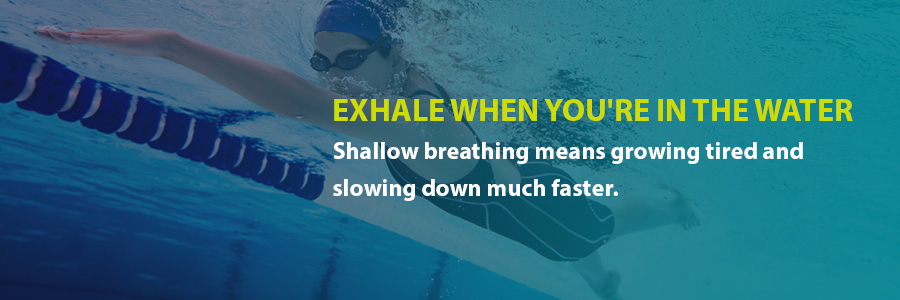
- Find your rhythm: Once you're comfortable exhaling while underwater, you can focus on finding the right breathing rhythm. Concentrate on making each breath and exhale the same length. During freestyle, do your workouts with bilateral breathing. This term means turning your head to both sides of your body to take a breath. This strategy will ensure that you're working the muscles on both sides of your body evenly. When it comes to race time, you can use bilateral or unilateral breathing.
Work on Flexibility and Strength Outside of the Pool
You can work on improving your swim times even when you're out of the water. Here are a few dry-land flexibility and strength training tips that can help improve your performance in the pool:- Work your core muscles: While it seems like your arms and legs do all of the work when it comes to swimming, you can't forget about your core muscles. If you want to maintain good technique and improve your speed, keep your core strong. On land, you can work your core with exercises like crunches, sit-ups, planks and scissor kicks. Maintaining a strong core takes regular exercise.
- Use an exercise ball: An exercise ball can be a great way to work on your shoulder muscle strength. Lie down with the exercise ball beneath your stomach. Put your feet on the floor hip distance apart. Raise your arms above your head, and point your thumbs toward the ceiling. Bring your arms together and then apart into a "Y" position. Repeat this exercise. Your shoulder muscles play a big role in moving you through the water, especially if you're looking to improve your butterfly speed.
- Stretch out: Stretching is an important warm-up for swimming and any other type of exercise. It helps keep your muscles and joints limber and prevent strains that will slow you down in the water. Great areas of focus for flexibility improvement include your pectoral muscles, neck muscles, quad muscles, calf muscles, hamstrings, hip flexors and latissimus dorsi muscles, which are located in your back.
Try Different Drills in the Water
Once you feel like you have a handle on your strokes and breathing, you can put those techniques to work during different drills in the water. Here are a few drills that work well for the four main types of swimming:- Freestyle: Try swimming freestyle with just one arm. Place your left or right arm either straight in front of you or pinned to your side. Then, complete lengths of the pool kicking with both legs and moving one arm. Trade arms to keep both sides of your body even. Then, vary arm-stroke speed. Swim with four quicker strokes of your arms, then slow your tempo for eight strokes. If you want to work on your kick technique, take your arms out of the equation. Do laps by holding onto a kickboard and focusing on your flutter kick.
- Breaststroke: Breaststroke drills are similar to freestyle drills. Swim laps using just one arm while the other remains in front of you or by your side. Alternate arms. When you want to work on your kick technique, grab a kickboard, and do laps with just the breaststroke leg movement.
- Backstroke: When it comes to backstroke, you can try drills that help improve core and leg muscle strength. Try three sets of 25 meters with your right arm up and your left arm down. Try another three sets, but switch which arm is up and which is down. Another drill: Use your arms evenly, but alternate six kicks with your right leg with six kicks with your left leg.
- Butterfly: You can focus on honing your butterfly arm technique by doing laps with the flutter kick. To work on your leg movement, try swimming butterfly with short fins. You can complete the arm movement every few leg movements during this drill. When you want to put both the arm and leg movements together, swim the stroke with clenched fists. Doing so will help improve your arm and leg coordination.
Know the Power of Practice
Practice is one of the most important tips to swim faster. You cannot master and maintain proper technique and improve your overall speed without getting in the water on a regular basis. This advice doesn't mean you have to live in the pool, but it does mean you need to commit to making swimming a part of your routine. It's possible to see improvement with a minimum of two to three vigorous workouts each week. Try different drills to find what works for you. If you can't get to the pool as often as you'd like, work on dry-land exercises that will help improve your swim performance.
Set Goals
If you're focused on how to become a faster swimmer, you'll need to track your progress carefully. Set goals for yourself, and measure your improvement. Of course, everyone's goals will be different, but here are a few baseline goals to consider:- 50-yard times: Swimming 50-yard drills is a great speed-training technique. Time yourself swimming this length. See if the time is within 95 seconds. If not, aim for that number. If you're swimming 50 yards in 95 seconds, aim for five seconds faster. Once you hit 90 seconds, see if you can do it faster. Once you've reached your peak time, work on maintaining that time for multiple sets.
- 100-yard times: When it comes to swimming 100 yards, you can aim for 160 seconds. Next, push yourself to complete 100 yards within 125 to 140 seconds. When you've reached your peak time, see how many sets you can finish at that time.
- Date your goals: When do you want to achieve your goals? Set a target date, and make a plan based on that date. Having something tangible to work toward is a powerful motivator.
- Break your goals into manageable steps: So you want to hit an incredible time. That's great, but how are you going to get there? Make your goal attainable by plotting out step by step the way you'll get there. Set a starting goal of getting into the pool a certain number of times per week. Set smaller goals for knocking time off your race bit by bit.
- Define your own success: Swimming is a competitive sport, but don't let that stop you from pursuing your own goals. While you practice, focus on what you're doing rather than what the person in the next lane is doing. When you reach a milestone or achieve a goal, remember to celebrate that success.
Invest in the Right Swimsuit and Gear
Proper technique, training and practice are the bulk of improving your swimming speed, but having the right equipment matters too. Here are three important pieces of gear that can help you achieve peak performance.- Swimsuit: The right swimsuit fits your body like a second skin, which means you're positioned to have a minimal amount of drag in the water. Swimsuits for competitive swimmers are designed to be as hydrodynamic as possible. When it comes to swimming performance, many athletes swear by tech suits. Finding something comfortable with the right fit for you is the key to finding the right swimsuit, whether that's a tech suit or not.
- Goggles: The right pair of goggles keeps your eyes clear so that you can keep your head in the right position and focus on the rest of your technique. Try a few different shapes and sizes to find the pair that fits your eye sockets and feels comfortable.
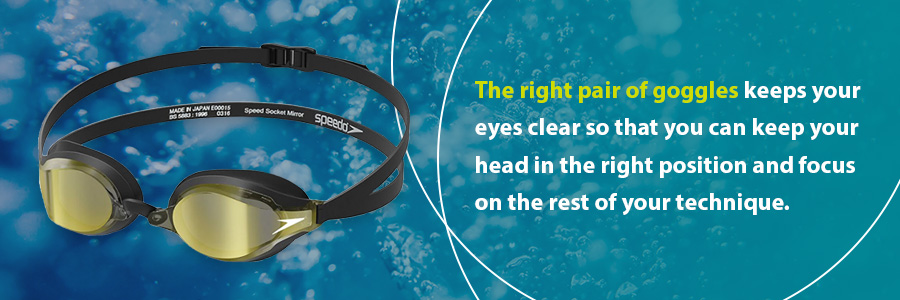
- Swim cap: If you have long hair, it will cause a little more drag in the water. If you want to feel even more hydrodynamic (without shaving your head), a swim cap will be a good investment.




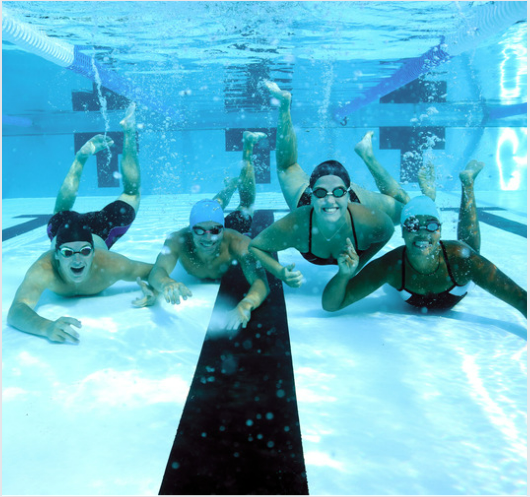


Leave a Comment
Your email address will not be published. Required fields are marked *